
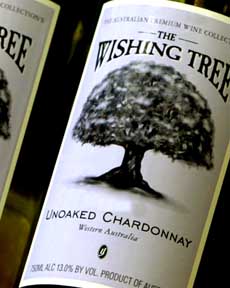 Make a wish...and discover exciting new Southern Hemisphere wines. The Wishing Tree and other wines are available from EnglewoodWineMerchants.com.
Make a wish...and discover exciting new Southern Hemisphere wines. The Wishing Tree and other wines are available from EnglewoodWineMerchants.com.
|
R. VERONIQUE FITZGERALD is wine consultant and writer in New York City.
|
|
April 2007 |
 |
Product Reviews / Main Nibbles / Wine
Southern Hemisphere Wines:
A Festival Of Australian, New Zealand & South African Wine Selections
CAPSULE REPORT: If your wine-buying focuses on the U.S. and Europe, you’re missing half a world of good wine. Here are some recommendations of tasty and affordable options from the other side of the equator. Among the more than one dozen recommendations below, don’t overlook d’Arenberg The Hermit Crab Viognier Marsanne McLaren Vale and Cape Mentelle Sauvignon Blanc Semillon Margaret River from Australia, Man Vintners Chenin Blanc from South Africa and Amisfield Pinot Noir Central Otago from New Zealand.
We enjoy imports from the Southern Hemisphere that line retail shelves and are featured on wine lists all over the U.S. Americans have happily embraced wines from Argentina, Australia, Chile, New Zealand and South Africa. They’ve become part of the landscape, although the landscapes they come from are all their own.
While we snowboard, ice skate, or otherwise hibernate in the north, our mates on the other side of the equator barbecue, surf and watch their grapes grow. As buds burst in North America and Europe this month and next, grapes ripen in the south and the 2007 vintage is underway. Let’s revisit the latest in crisp, young whites and fresh, juicy reds from Australia, New Zealand and South Africa as we await the arrival of the first ‘07s this summer. (NOTE: While bottle age on the reds is good, the whites need to be drunk young: buy the 2006 vintage, nothing earlier).
There are two common veins among Southern Hemisphere wines: the intrepid, unabashedly unique styles, and the beloved screw top.
New Zealand Wines
From Keri Keri in the subtropical far north, with its long summers and conspicuous shortage of snow, to Central Otago in the Southern Alps, where alpine parrots called Keas gnaw at ski and snowboard roof racks, wine grapes live in a wide variety of climates. Although U.S. imports of New Zealand wines are small—comprising a mere 1% of the wines imported into the U.S.—the numbers are growing in leaps and bounds and the wines are well-received.
According to Philip Gregan, CEO of New Zealand Winegrowers, the weather this year has been lovely and warm; and although the crop will not be as large as expected, it will still be larger than ever. The shortfall may be attributed to some cool summer days: Temperatures were around 55˚F in late January on the North Island and some days were in the 40s in Central Otago. It warmed up in February, but enough cool will prolong ripening, thereby leaving grapes on the vine for a longer period, vulnerable to rot and hungry birds.
Summer in New Zealand need never be boring. In the far southern climes of Otago, one can enjoy kayaking in majestic lakes and rivers, hiking, fishing and bungee jumping, as well as touring and tasting at the region’s wineries. On the North Island, Hawke’s Bay's Mission Estate hosts an outdoor summer concert in a natural amphitheater featuring Eric Clapton, and beautiful beaches around the Coromandel Peninsula call you to escape busy Auckland City. There is a relaxed feel outside the cities, an easygoing vibe echoed by the ubiquity of the screwcap wine bottle. No worries, mate!
Nonetheless, it’s all work and no play during harvest for wine country. “Vintage is only in the very early stages and won’t be over until mid-May,” says Mr. Gregan. “Only after the final grapes are harvested and the vintage total is known, will the celebrations start.” While we wait, we can celebrate the 2006 vintage, now on the shelves, while we wait for the first of the 2007s to land on our shores.
While there are exceptions to every statement, New Zealand wines such as Pinot Gris, Pinot Noir, Riesling and Syrah are cool climate wines, generally showing more restrained fruit and higher acidity than those of Australia and California. This style of wine has many fans—and it’s not an either/or choice. That’s why we’re fortunate to be able to select from varietals grown all over the world, each region offering its own flavors and styles of vinification.
- Crossroads Sauvignon Blanc Marlborough 2006 ($13.00-$15.00)
This is a lovely wine, with fruit from various areas of Marlborough including the popular Wairau Valley and the smaller valleys of Waihopai and Awatere. As a result, it is a less aggressive, more nuanced style, with minerality and grassiness enough to compliment lovely passionfruit on the palate. It holds up really well in the fridge as well, tasting nearly as fresh five days later as the first day the screwcap was cracked. Crisp, well-balanced Marlborough Sauvignon Blanc starting at around $12.00 a bottle loves fresh, briny oysters, possibly because the Marlborough region benefits from a maritime climate. Stick to ‘06 sauvies—anything older is likely to be tired, for even the best (and most expensive) of them are made to be consumed within 1 to 2 years of release. Easter celebrants can serve one with a fish dinner on Good Friday.
Other producers to look for include Grove Mill, Babich, Kim Crawford and Brancott.
|
|
- Goose Bay Sauvignon Blanc Marlborough 2006 Kosher/Mevushal ($15.00)
For my Passover posse, this is a new addition to the intriguing international selection of Kosher wines one can find. It shows the classic style with a bold, passionfruit aroma, if a bit less tropical and a bit less crisp than some popular bottlings. Certified kosher by the Kashrut Authority. Natural cork.
- Seifried Gewürtztraminer Nelson 2006 ($15.00-18.00)
This Nelson estate is a forerunner in New Zealand’s modern wine industry. Their Gewürtztraminer is a top wine from the region, made by Heidi Seifried, a second-generation winemaker. Lychee, star fruit and other Southeast Asian tropical aromas laced with rose petals leap out of the glass before it touches your palate. This wine has attitude, with a vein of spice to season the fruit, finishing dry. Try this wine with curry chicken or goat!
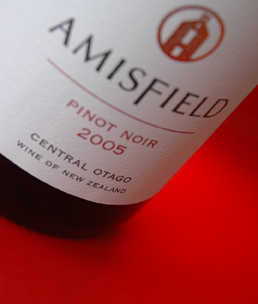
|
- Amisfield Pinot Noir Central Otago 2005 ($35.00)
Central Otago is one of New Zealand’s premier regions for Pinot Noir, and this wine definitely lives up to that accolade. It has opulent fruit and mountain air aromas and is nicely balanced with ripe berry fruit, good acidity and hints of smoke and earth. This wine is no lightweight: Venison, better cuts of beef and lamb would be right up this Pinot’s alley.
|
- Pinots at more tame prices are made by such producers as Saint Clair (look for the Vicar’s Choice, $12-$15), Matua and Villa Maria, among others. However, these are from Marlborough and not as complex and rich as their counterparts from Central Otago or the other Pinot Noir star, Martinborough. Even the higher-priced wines are bottled with screwcaps!
South African Wines
A key to understanding South African wine is to think of the Rainbow Nation as an old world wine country—the European feel of South Africa’s wines is what sets them apart from other Southern Hemisphere countries. The wines are not fruity like typical warm-climate wines; yet they can’t quite be compared directly with French counterparts–a South African Viognier is not similar to Condrieu, for example. The flavor of terroir, so strong in French wines, is generally absent.
The earliest known record of South African wine production was written in 1652 by a Dutch surgeon settler. The first wine estate was Constantia, established in 1685 just outside Cape Town. At their best, the wines are usually not fruity, except at the lower end ($6.00-$10.00). The more crafted wines are stylish and independent, often earthy, always esoteric.
On March 1, the harvest was in progress and was expected to be “completed earlier 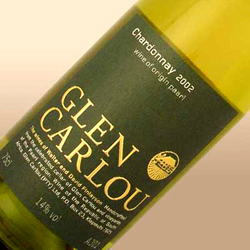 than the norm.” The crop is expected to be smaller than usual, but not by much. The Western Cape, or vineyard areas surrounding Cape Town, had nice weather for most of the season. A summer trip could begin at the Cape Town Festival (usually 20 or so days long in the month of March), where comedy, film, music events, theater and visual arts can be enjoyed. Then, a 45 minute drive east will put you in Stellenbosch, a wine region known for its great reds, demarcated by a gorgeous university town of the same name. While there, try a samp (ground maize cooked in water like grits or porridge) and black-eyed pea salad or some masala-dusted ostrich steaks. Better still, enjoy South African wines with family and friends over a long braai (a barbecue) of marinated sosaties (kebabs) of ostrich or chicken, lamb chops and wors, a spicy sausage, usually made of beef—I'm told no braai is complete without them. Butternut squash and whole potatoes are also roasted on the braai. All can be enjoyed with wines made from a wide variety of cultivars (grape varieties). If you are fortunate enough to visit this fascinating country, grab a copy of Good Taste magazine as soon as you arrive. than the norm.” The crop is expected to be smaller than usual, but not by much. The Western Cape, or vineyard areas surrounding Cape Town, had nice weather for most of the season. A summer trip could begin at the Cape Town Festival (usually 20 or so days long in the month of March), where comedy, film, music events, theater and visual arts can be enjoyed. Then, a 45 minute drive east will put you in Stellenbosch, a wine region known for its great reds, demarcated by a gorgeous university town of the same name. While there, try a samp (ground maize cooked in water like grits or porridge) and black-eyed pea salad or some masala-dusted ostrich steaks. Better still, enjoy South African wines with family and friends over a long braai (a barbecue) of marinated sosaties (kebabs) of ostrich or chicken, lamb chops and wors, a spicy sausage, usually made of beef—I'm told no braai is complete without them. Butternut squash and whole potatoes are also roasted on the braai. All can be enjoyed with wines made from a wide variety of cultivars (grape varieties). If you are fortunate enough to visit this fascinating country, grab a copy of Good Taste magazine as soon as you arrive.
Continuing the popularity of screwcaps, apart from the Glen Carlou Chardonnay, all of the South African wines mentioned here are under screwcap.
- Glen Carlou Chardonnay 2004 ($10.00-15.00)
This Chardonnay is creamy with a toasty-earthy feel. It is a hint nutty and the palate mimics richly flavored birds and pork. Both the 2003 and 2005 are on the market. With its body and balance, I would continue to drink this wine for another three to five years, so feel free to try the older vintage if that’s what you find.
- Neil Ellis Sincerely Sauvignon Blanc 2006 ($15.00)
In typical South African fashion, this wine is much less fruit-driven and much more herbaceous. On the nose, one recalls Sancerre and its characteristic gooseberry (often affectionately, or derisively, referred to as cat’s pee). It is crisp and herbaceous, with mineral notes: a well-made wine that would be magic with salads (hold the vinaigrette) and oilier fishes. The Sincerely Shiraz, also $15.00, showed black pepper and smoke on the nose and deep blackberry fruit on the palate. Silky tannin and crisp acidity make you want another glass with another ostrich sosatie off the braai.
- Man Vintners Chenin Blanc 2006 ($9.00-10.00)
A personal favorite, this wine is both fun and a great value. There’s a bit of fruitiness here, and overall it is clean and bright on the tongue with crisp, citric acidity. Drinking this last summer and autumn was a pleasure, but this wine is on the wane. Man’s Chenin is obviously best fresh, so look forward to the arrival of the ‘07. There is an entire line of Man Vintners wines in the same price range, including a well-made Cabernet Sauvignon 2005 for your wors and lamb chops, and an intense Pinotage 2005 whose juicy sour cherry, blueberry and licorice flavors and coarse tannin yearn for rare red meats—maybe those ostrich steaks!
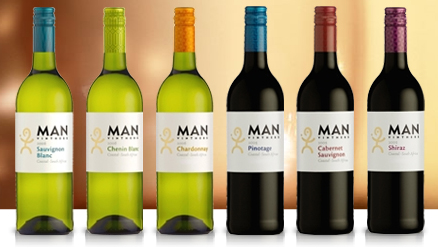
- Fairview Viognier 2006 ($20.00)
Here’s a wine to impress your more wine-savvy friends with (for those who need to start with a pronunciation tip, it’s VEE-ohn-YAY). From an historic Paarl Valley estate established in 1693, the current winemaker was the first to plant Viognier in South Africa on the belief that the climate and granite soil he chose would be ideal. It seems to have paid off, in a wine that is complex and intriguing with hints of toast, violets and pineapple on the nose; its very mineral palate shows peach skin and toasty oak notes. This wine is voluptuous, with balanced acidity for bold cheeses or gamey fowl (Fairview is also well known for the cheeses it produces).
Australian Wines
Most serious American wine-drinkers have had had opportunities to taste Australian wine. What set these wines apart is great value for money, in part because they are a huge continent (two-thirds the size of the U.S.) with a small population. This provides large large tracts of inexpensive vineyard land, where wine can be produced more cost-effectively than, say, in California, where land does not come cheap.
As a result of a huge quantity of smartly priced wines, this dynamic nation has been able to capture a strong position in the global wine market. However, some industry professionals think that many opportunists rushed in too soon, planting lots of over-producing vineyards, which have contributed to an international grape glut, driving grape prices and, in some cases, overall quality, down.
Sixth-generation winemaker Scott McWilliam gave a harvest report from his 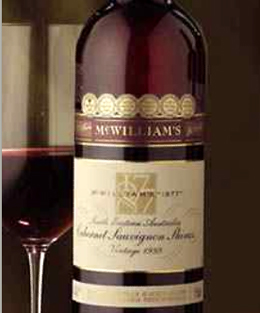 McWilliam’s Wines family estate in New South Wales, that tells of a plague of a vintage that may, on the bright side, correct the oversupply and stabilize the Aussie wine game. Overall, there has been 35% decrease from last year’s yield, the likes of which have not been seen since the mid 1970s. Coonawarra, in the state of South Australia, had the earliest harvest in living memory. The New South Wales regions of Hunter Valley and Riverina fared well, with smaller crops but higher quality (think of all that vintage goodness stuffed into a smaller package—mmmm, good!), whereas hailstorms pummeled vineyards in Canberra (Australia’s capital) and forest fires further south in the state of Victoria actually caused smoke damage in some vineyards, rendering acres of grapes useless. Heathcote, a Victorian region, escaped this peril, yielding a smaller quantity of extra-intense Shiraz grapes. McWilliam’s Wines family estate in New South Wales, that tells of a plague of a vintage that may, on the bright side, correct the oversupply and stabilize the Aussie wine game. Overall, there has been 35% decrease from last year’s yield, the likes of which have not been seen since the mid 1970s. Coonawarra, in the state of South Australia, had the earliest harvest in living memory. The New South Wales regions of Hunter Valley and Riverina fared well, with smaller crops but higher quality (think of all that vintage goodness stuffed into a smaller package—mmmm, good!), whereas hailstorms pummeled vineyards in Canberra (Australia’s capital) and forest fires further south in the state of Victoria actually caused smoke damage in some vineyards, rendering acres of grapes useless. Heathcote, a Victorian region, escaped this peril, yielding a smaller quantity of extra-intense Shiraz grapes.
Thus, this is a unique vintage. Even the lower-priced wines we buy daily for our French Paradox diets may increase in price; but the quality is also likely to be better. Mr. McWilliam directed us to the Australian Cuisine portion of his winery's website for recipes and food pairings. He guiltily admits having favorites among his “children,” including his McWilliam’s Hanwood Estate Riesling South Eastern Australia 2005, which is paired with spicy chicken samosas, fish stir fry and minted shrimp with orange salsa; and his Cabernet Sauvignon (consistent style from year to year, 2004 is currently available in stores) which is paired with two salads with pancetta and barbecued pork. Both of these wines are around $9.00 a bottle.
- Cape Mentelle Sauvignon Blanc Semillon Margaret River 2006 ($15.00)
This is a favorite, in a style Australia has embraced, blending crisp, fruit-driven Sauvignon Blanc with sexy, pheromone-like Semillon (the Aussies pronounce the L consonants [seh-mih-LON], the French don’t [seh-mee-YOAN]) to create a wine that has multiple layers of flavor. Cape Mentelle brings sexy back with its edgy version of the blend, showing grapefruit and bitter greens on the palate.
Barwick Sauvignon Blanc Semillon Western Australia 2005 ($10.00) is one of several less expensive alternatives, just as delish, but more rare.
- D’Arenberg The Hermit Crab Viognier Marsanne McLaren Vale 2005 ($15.00)
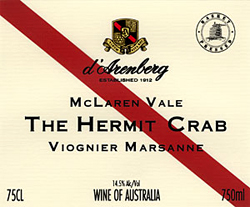 So-named because it comes from soil that is rich in marine fossils, particularly fossils of hermit crabs, my first sniff of this wine last summer at a dinner in a trendy midtown Manhattan restaurant reminded me of crushed oyster shells and sea salt. From another old family estate in Adelaide, this was my “wine of the year” last year. The nose shows notes of clove, sage, mineral and melon. Overall, it is sort of briny, reminiscent of the ocean, with hints of citrus. This wine is in a screwcap and will be easy to spot in d’Arenberg’s trademark red stripe package. So-named because it comes from soil that is rich in marine fossils, particularly fossils of hermit crabs, my first sniff of this wine last summer at a dinner in a trendy midtown Manhattan restaurant reminded me of crushed oyster shells and sea salt. From another old family estate in Adelaide, this was my “wine of the year” last year. The nose shows notes of clove, sage, mineral and melon. Overall, it is sort of briny, reminiscent of the ocean, with hints of citrus. This wine is in a screwcap and will be easy to spot in d’Arenberg’s trademark red stripe package.
- The Wishing Tree Shiraz 2004 ($7.00-10.00)
This wine is a blend of grapes from Western Australia and South Australia, and admittedly, it was the label that made me pick it up the first time I tried it. This is a step up from the garden variety under-ten-dollar- mascot-adorned-bug-juice that is so popular these days, with a bit less of the jammy fruit and more smokiness and tannin. Other great producers in the $10.00 range that also come in screwcap bottles are Nine Stones, Paringa and Barwick. Look mom, no critters! The 2005 vintage can be found in some stores.
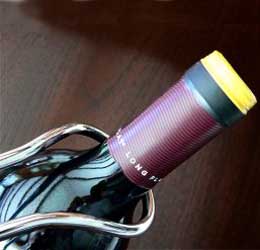
Under the plastic (not foil) seal: You can see it’s not a cork, but a screwcap. Photo by Neil Gould.
|
About Screwcap Wine Bottles
There’s a controversy over screwcap bottles, because they harken back to the days of cheap wine—aluminum caps were cheaper than cork. But today, good wines meant to be drunk in the short-term are using screwcaps. It’s more environmentally sound and produces more reliable wine.
First, it takes 20 years for a cork tree sapling to grow to where it can be stripped of its bark; it takes 9 to 10 years for the bark to regenerate, and a tree will live for just 200 years (olive trees can live for 1,000 years). A cork tree in its prime, about 80 years old, will produce 25,000 wine bottle-size corks.
|
Cork has been the traditional bottle-stopper for millennia. We know how it affects the aging of a wine that will be laid down for for 10, 20 or 30 years or more. We don’t yet know how the same wine will age with a plastic cork or a screw-top: Tests are underway with synthetic corks being tested to replace natural corks in wines that are aged, but will take years to prove out. There is little risk for a short-horizon wine—which will be drunk in five years or less—to have a screwcap closure or a synthetic cork.
A second benefit is that both screwcaps and synthetic corks avoid “corked” wines, a mildew-smelling* taint that comes from the chemical compound trichloroanisole (TCA) in an improperly-cleansed cork. The bad smell and/or taste in the wine is off-putting, although the wine is not harmful to drink. Corked wine is often cited as the most common cause of spoiled wine: There are estimates that 2% to 5% of wines bottled with cork may end up spoiled because of TCA—including the most expensive ones. Every wine collector opens several bottles of very pricey, aged wine each year that is “corked.” There is no redress: The bottle can’t be returned to the winemaker for an exchange.
Hopefully, synthetic corks will eliminate the problem of corked wine; however, the wine-buying public must get over any objection to them. Synthetic corks and aluminum screwcaps cleanly cap the wine without contaminating the contents: Everyone wins.
*Also described as moldy or musty.
As the sun sets on the other side of the equator,
it sets on countries that offer a host of unique, interesting wines that bring new twists on old themes. Due to the length of this article, we’ll save a discussion of Chilean and Argentinian wines for another time. Don’t hesitate to get recommendations from your merchant and try them on your own. There are good choices at good prices, and with Southern Hemisphere wines in the mix, meals, wine group meetings and lazy weekend afternoons need never feature the same wine twice.
Lifestyle Direct, Inc. All rights reserved. Images are the copyright of their respective owners.

|





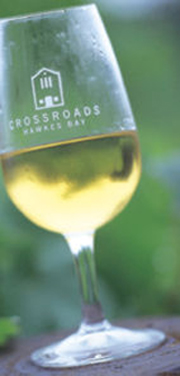

 than the norm.” The crop is expected to be smaller than usual, but not by much. The Western Cape, or vineyard areas surrounding Cape Town, had nice weather for most of the season. A summer trip could begin at the
than the norm.” The crop is expected to be smaller than usual, but not by much. The Western Cape, or vineyard areas surrounding Cape Town, had nice weather for most of the season. A summer trip could begin at the 
 McWilliam’s Wines family estate in New South Wales, that tells of a plague of a vintage that may, on the bright side, correct the oversupply and stabilize the Aussie wine game. Overall, there has been 35% decrease from last year’s yield, the likes of which have not been seen since the mid 1970s. Coonawarra, in the state of South Australia, had the earliest harvest in living memory. The New South Wales regions of Hunter Valley and Riverina fared well, with smaller crops but higher quality (think of all that vintage goodness stuffed into a smaller package—mmmm, good!), whereas hailstorms pummeled vineyards in Canberra (Australia’s capital) and forest fires further south in the state of Victoria actually caused smoke damage in some vineyards, rendering acres of grapes useless. Heathcote, a Victorian region, escaped this peril, yielding a smaller quantity of extra-intense Shiraz grapes.
McWilliam’s Wines family estate in New South Wales, that tells of a plague of a vintage that may, on the bright side, correct the oversupply and stabilize the Aussie wine game. Overall, there has been 35% decrease from last year’s yield, the likes of which have not been seen since the mid 1970s. Coonawarra, in the state of South Australia, had the earliest harvest in living memory. The New South Wales regions of Hunter Valley and Riverina fared well, with smaller crops but higher quality (think of all that vintage goodness stuffed into a smaller package—mmmm, good!), whereas hailstorms pummeled vineyards in Canberra (Australia’s capital) and forest fires further south in the state of Victoria actually caused smoke damage in some vineyards, rendering acres of grapes useless. Heathcote, a Victorian region, escaped this peril, yielding a smaller quantity of extra-intense Shiraz grapes.  So-named because it comes from soil that is rich in marine fossils, particularly fossils of hermit crabs, my first sniff of this wine last summer at a dinner in a trendy midtown Manhattan restaurant reminded me of crushed oyster shells and sea salt. From another old family estate in Adelaide, this was my “wine of the year” last year. The nose shows notes of clove, sage, mineral and melon. Overall, it is sort of briny, reminiscent of the ocean, with hints of citrus. This wine is in a screwcap and will be easy to spot in d’Arenberg’s trademark red stripe package.
So-named because it comes from soil that is rich in marine fossils, particularly fossils of hermit crabs, my first sniff of this wine last summer at a dinner in a trendy midtown Manhattan restaurant reminded me of crushed oyster shells and sea salt. From another old family estate in Adelaide, this was my “wine of the year” last year. The nose shows notes of clove, sage, mineral and melon. Overall, it is sort of briny, reminiscent of the ocean, with hints of citrus. This wine is in a screwcap and will be easy to spot in d’Arenberg’s trademark red stripe package. 